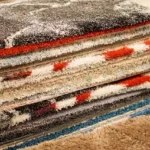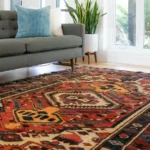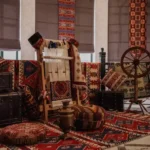Choosing the right carpet for your home is a significant decision, and it’s crucial to clearly understand the various carpet types with different materials, fibers, weaves, and pile heights. In this comprehensive guide, we’ll look into the world of different types of carpet fibers, both natural and synthetic, and provide insights into their advantages and disadvantages. We’ll also explore popular carpet weaves like Berber, materials like nylon and wool, and factors like pile height, density, and texture. This article aims to empower you with the knowledge needed to evaluate carpet quality and make an informed choice for your flooring needs.
Carpet Materials: Natural Fiber vs. Synthetic Fiber
Carpet is a popular choice for residential and commercial flooring, known for its comfort, versatility, and array of textures, colors, and styles. When it comes to carpet fibers, there are two primary categories: natural and synthetic.
Natural Fiber Carpet
Natural fiber carpets are made from materials derived from plants or animals, rather than being synthetically manufactured. The most common natural fibers used in carpet are wool and sisal.
Wool Carpet:
Wool is a natural fiber famous for its durability, comfort, and flame retardancy. It’s an excellent insulator, keeping your home cozy year-round. Wool carpets are well-suited for high-traffic areas like hallways and living rooms.
Pros of Wool Carpet:
- Durable: Resistant to wear and tear with a long average life.
- Comfortable: Naturally soft and comfortable underfoot, good for bedrooms.
- Flame Retardant: Naturally fire-resistant.
- Stain-Resistant: Less likely to show stains.
- Hypoallergenic: Less likely to trigger allergies.
- Sustainable: Renewable and biodegradable.
Cons of Wool Carpet:
- Expensive: Wool carpets are pricier.
- Cleaning Challenges: Can be difficult to clean.
- Pilling: Susceptible to pilling.
Silk Carpet:
Silk offers a luxurious, soft feel, and it’s naturally stain-resistant. However, it’s relatively expensive, making it ideal for bedrooms and allergy-sensitive homes.
Pros of Silk Carpet:
- Soft and Luxurious: Exceptionally soft and luxurious, a sign of luxury carpet.
- Stain-Resistant: Naturally resists stains.
- Durable: Withstands wear and tear.
- Fire Resistant: Naturally fire-resistant.
- Hypoallergenic: Allergy-friendly.
Cons of Silk Carpet:
- Expensive: Higher cost.
- Cleaning Challenges: Requires careful cleaning.
- Fading: Can be susceptible to fading.
Sisal Carpet:
Sisal, derived from sisal plant leaves, is extremely durable and hypoallergenic, making it suitable for high-traffic areas.
Pros of Sisal Carpet:
- Durable: Resistant to wear and tear with a long life.
- Naturally Stain-Resistant: Less likely to show stains.
- Eco-Friendly: Renewable and biodegradable.
- Noise Absorbent: Reduces noise.
- Comfortable Underfoot: Soft and comfortable texture.
Cons of Sisal Carpet:
- Slippery: Can be slippery.
- Cleaning Challenges: Requires careful cleaning.
- Fading: Can be susceptible to fading.
Synthetic Fiber Carpet
Synthetic carpets utilize human-engineered fibers rather than natural materials. The most common synthetic carpet fibers include nylon, polyester, olefin, and acrylic. These are made from petroleum-based chemicals.
Nylon Carpet:
Nylon, a synthetic fiber, is known for its durability, stain resistance, and affordability. It’s suitable for most rooms and homes with pets.
Pros of Nylon Carpet:
- Durable: Resistant to wear and tear, a long-lasting hard-wearing carpet.
- Stain-Resistant: Less likely to show stains.
- Affordable: Budget-friendly.
- Good Insulator: Maintains temperature.
- Easy to Clean: Simple maintenance.
- Resistant to Pet Stains: Ideal for pet owners.
- Resilient: Bounces back from compression, good for high traffic areas.
Cons of Nylon Carpet:
- May Be Slippery: Some may find it slippery.
- Not as Soft: Not as soft as other fibers.
- Limited Sound Absorption: Less sound absorption.
Polyester Carpet:
Polyester offers a soft, luxurious feel, stain resistance, and water resistance, all at an affordable price point.
Pros of Polyester Carpet:
- Durable: Resistant to wear and tear.
- Stain-Resistant: Less likely to show stains.
- Affordable: Budget-friendly.
- Good Insulator: Maintains temperature.
- Easy to Clean: Simple maintenance.
- Wrinkle Resistant: Doesn’t wrinkle easily.
- Colorfast: Colors don’t fade.
Cons of Polyester Carpet:
- Not as Soft: Softer options exist like wool.
- Limited Sound Absorption: Less sound absorption.
Olefin Carpet:
Olefin, another synthetic fiber, is known for its durability, stain resistance, and affordability. It’s suitable for high-traffic areas.
Pros of Olefin Carpet:
- Durable: Resistant to wear and tear.
- Stain-Resistant: Less likely to show stains.
- Affordable: Budget-friendly.
- Good Insulator: Maintains temperature.
- Easy to Clean: Simple maintenance.
- Resistant to Mold and Mildew: Doesn’t easily develop mold.
- Non-Absorbent: Doesn’t absorb liquids.
Cons of Olefin Carpet:
- May Be Slippery: Some may find it slippery.
- Not as Soft: Not as soft as other fibers.
- Limited Sound Absorption: Less sound absorption.
Acrylic carpets:
Acrylic carpet is made from acrylic fibers derived from coal, air, water, oil, and limestone.
Pros of Acrylic Carpet:
- Soft Texture: Acrylic carpet has a soft, wool-like feel and appearance. This makes it comfortable underfoot.
- Color Versatility: Available in a wide spectrum of colors from light to vivid hues. Acrylic accepts dye readily.
- Affordability: More affordable than premium fibers like wool or nylon. A budget-friendly synthetic option.
- Easy Cleaning: Acrylic resists stains and can be spot-cleaned with water and mild soap. Vacuuming restores the pile.
Cons of Acrylic Carpet:
- Lacks Durability: Acrylic carpet fiber is not as strong or resilient as other synthetics like nylon. It shows wear sooner.
- Poor Resistance: Acrylic is prone to matting, crushing, and flattening from foot traffic. It may need frequent raking or vacuuming.
- Fades Over Time: Acrylic carpet will slowly fade and lose its vibrancy when exposed to sunlight. Not as colorfast.
- Attracts Oil: The fibers tend to readily absorb oil, grease, and other household soils. Frequent cleaning is a must.
Blended Carpet:
Blended carpets combine the strengths of different fibers. Wool-nylon blends offer durability and comfort, while polyester-olefin blends provide affordability and stain resistance.
Pros of Blended Carpet:
- Durable: Resistant to wear and tear.
- Stain-Resistant: Less likely to show stains.
- Affordable: Budget-friendly.
- Softness and Comfort: Varied textures.
- Versatile: Available in various colors and patterns.
Cons of Blended Carpet:
- Durability varies and may not be as durable as Pure Wool or Nylon.
Berber Carpet:
Berber carpet features a looped pile construction that creates a textured, nubby appearance. It is durable, comfortable, and ideal for high-traffic areas.
Pros of Berber Carpet:
- Durable and long-lasting.
- Affordable option.
- Easy to clean.
- Good for high-traffic areas.
- Available in a variety of colors.
Cons of Berber Carpet:
- Can show footprints.
- Limited softness.
Textured Carpet:
Textured carpets like Saxonies, friezes, and cabled carpets offer varying heights and twists of yarn to create interest and hide dirt.
Pros of Textured Carpet:
- Hide dirt well.
- Durable.
- Versatile styling.
- Softer feel.
Cons of Textured Carpet:
- Slightly harder to clean.
- Can show footprints.
Plush Carpet:
Plush carpets feature a smooth, velvety surface with a luxurious look and feel.
Pros of Plush Carpet:
- Very soft and comfortable underfoot.
- Luxurious, upscale appearance.
- Shows footprints less.
Cons of Plush Carpet:
- More expensive.
- Requires frequent vacuuming.
- Can crush and matt down over time.
Choosing the Right Carpet:
When selecting a carpet, consider the fiber type, pile height, density, texture/weave, warranties, purpose, traffic, and your budget. Consult with a carpet professional for personalized advice tailored to your needs.
Key factors when evaluating carpet quality include:
- Fibre type: Wool, nylon, and blended fibers tend to be more durable.
- Pile height: Low or medium piles hide dirt well. Plush piles feel luxurious.
- Density: Higher densities feel more luxurious.
- Texture: Level loops or tight twists hide dirt. Cut piles feel plush.
- Backing material: Woven backings are more durable than glued.
- Warranty length: Longer warranties signal better quality.
- Stain protection treatments: Help resist stains.
Test carpets for durability, appearance retention, resistance to crushing/matting, and how they feel underfoot. Avoid low-quality carpets with thin face weights.
Final thoughts on the different Types of Carpet:
Selecting the perfect carpet involves understanding key factors like fiber types, construction, pile height, and density. Consider your budget, traffic, and needs. By following these guidelines, you can make an informed decision that enhances the comfort and aesthetics of your home.
FAQS:
Which carpet is best for high-traffic areas?
Nylon, wool, and synthetic-wool blend carpets are the most durable options for high-traffic areas in homes. Olefin or Berber can also withstand heavy wear.
What is the thickest, plushest carpet?
Frieze and Saxony carpets, with cut pile heights up to 2 inches, offer the thickest, fullest, and most luxuriously plush textures. But they require frequent vacuuming.
What carpet works best for hallways?
For hallways, Berber, low pile, or low-density carpets are ideal. Their tight loops hide footprints while withstanding frequent traffic in transitional spaces.
Which type of carpet is most popular?
Nylon carpet is the most popular and widely used type of carpet today.



